|
The
Changing Faces |
|
|
Ask
any Australian to put a name to motorsport and the most likely match
will be Peter Brock. In fact Brock and his generation of gracefully
ageing "gentleman racers" have defined our domestic motorsport
culture. The motley fraternity of greying stalwarts like Johnson,
Perkins, Richards and Moffat has made enormous contributions to
our homegrown brand of noisy circuit racing. Now the 'good ole boys'
are moving aside, often unwillingly, for a brazen, vigorous band
of young upstarts.
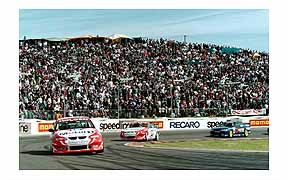 Leading
this precocious 'brat pack' is 25-year-old Craig Lowndes, probably
the most familiar face of Australian motor racing in recent years.
After emerging victorious from the 1993 Formula Ford Championship,
the acknowledged breeding ground for our supersonic youngsters,
Craig found himself being courted by the famous Holden Racing Team.
His talent was rewarded with a co-drive alongside Brad Jones in
the team's second car at the 1994 Bathurst 1000 and the breath-taking
challenge he threw down to eventual winner John Bowe is now legend. Leading
this precocious 'brat pack' is 25-year-old Craig Lowndes, probably
the most familiar face of Australian motor racing in recent years.
After emerging victorious from the 1993 Formula Ford Championship,
the acknowledged breeding ground for our supersonic youngsters,
Craig found himself being courted by the famous Holden Racing Team.
His talent was rewarded with a co-drive alongside Brad Jones in
the team's second car at the 1994 Bathurst 1000 and the breath-taking
challenge he threw down to eventual winner John Bowe is now legend.Given a full season drive in 1996 alongside Peter Brock, he completely dominated the V8 category that year, toppling all opposition in the Shell Australian Touring Car Championship, Sandown 500 and Bathurst 1000 events. His skyrocketing success flamed out somewhat in '97 with a lacklustre year overseas in international Formula 3000, but he burst back on our scene in '98 with another resounding Australian Touring Car Championship series victory. That kind of success does not go unnoticed. 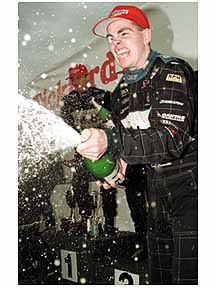 Lowndes
also possesses a disarmingly boyish exuberance that is so often
displayed in the winners' circle. His unbridled glee in victory
is so heartwarming that even devout Ford fans who, after cursing
the faceless Holden-badged helmet all day, suddenly find themselves
offering up congratulations along with his own army of raucous fans.
In the post race conferences, 'the kid' is quick to thank his hard-working
team "who gave me this great car" and uncomfortable with
the lavish praise that is so often heaped on him. Lowndes
also possesses a disarmingly boyish exuberance that is so often
displayed in the winners' circle. His unbridled glee in victory
is so heartwarming that even devout Ford fans who, after cursing
the faceless Holden-badged helmet all day, suddenly find themselves
offering up congratulations along with his own army of raucous fans.
In the post race conferences, 'the kid' is quick to thank his hard-working
team "who gave me this great car" and uncomfortable with
the lavish praise that is so often heaped on him. Growing up in and around motor racing, Lowndes was preordained for the sport. His father Frank is a skilled racing car technician, having worked alongside many of the famous names. He built Brock's first Torana XU-1. Young Craig spent most of his youth and childhood observing the great men, and his association with Peter Brock is no coincidence. Brock himself spent a great deal of time mentoring the emerging champion before, during and after their time together in the Mobil Holden Racing Team. "Peter helped me enormously when I first came on the scene," says Craig "particularly in dealing with the media, something I had very little skill in. I really didn't know who was who or what was what back then and I was very lucky to have Peter guiding me through a lot of that. The way he presents himself and his subjects is quite unique and I hope a little bit of him has rubbed off on me." Brock and Lowndes' early success runs parallel in many ways. Both were young stars in Holdens with spectacular early career results that led them to achieve a status that set them apart from, or above, their peers. "Craig certainly has was it takes in terms of raw driving talent," says Brock "and he doesn't take sponsors for granted either. Some kids reckon the world owes them a living and that's not the way Craig thinks." 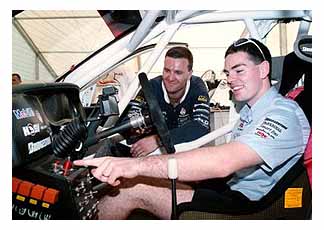 Another
common thread is their personal association with Mobil, a company
that has shown an uncanny knack in identifying and consolidating
talent. Mobil stuck with Brock during his difficult period in the
1980s, and likewise maintained support for Lowndes during his 1997
low point. Now Mobil is in the enviable position of having two highly
identifiable personalities at each end of the demographic spectrum
- and both have earned enormous respect and recognition within each
other's boundaries. Another
common thread is their personal association with Mobil, a company
that has shown an uncanny knack in identifying and consolidating
talent. Mobil stuck with Brock during his difficult period in the
1980s, and likewise maintained support for Lowndes during his 1997
low point. Now Mobil is in the enviable position of having two highly
identifiable personalities at each end of the demographic spectrum
- and both have earned enormous respect and recognition within each
other's boundaries.Oil company alignment with motoring identities goes right back to the turn of the century when Shell fuelled the Pirelli-sponsored Prince Scipione Borghese in his 1907 Peking to Paris win. Castrol/Wakefield began around the same time and were soon trumpeting their victories in events like the Tourist Trophy for motorcycles. Despite Australia's long and colourful history with motorsport, our domestic categories are only now reaching a level of professionalism on par with the rest of the world. As with any action for radical change, there is a certain amount of turmoil in the establishment as new, aggressive marketing forces make their moves. IMG, and more recently SEL through Tony Cochrane, have turned much of the staid infrastructure on its ear. V8 Supercars, as our premier touring car category is now known, stunned track promoters by pushing strongly for appearance fees and comprehensive circuit upgrades. This revolution has catapulted V8 Supercars to a level where they are now starting to attract the same media attention as football, golf and cricket. Riding this crest are the 'young guns', lifting their respective sponsorship and endorsement worth as they go. This new face of youth has refreshed the personality stocks of motor racing that was decidedly stagnant and stale by the early 1990s. Many name drivers were pushed well past their use-by dates and entry for young drivers was extremely difficult and expensive. Privateer teams were the only entry-level opportunity for up-and-coming drivers and many burned their budgets and reputations with uninspiring performances in below-par teams. In the tradition of tennis and golf, personal sponsorship is now enabling young drivers to find their way into the best seats. A long established overseas practice for aspiring Formula One drivers, candidates must first purchase their drives in F3 or F3000 before hopefully gaining the attention of factory teams with salaried pilots. Our own Mark Webber, for example, owes much of his early opportunities to personal support from Yellow Pages. Lowndes' fiercest rival, Russell Ingall, now 35 and enjoying a quality drive with Larry Perkins' Castrol Racing Team, had to fight for every crumb. Despite winning championships both here and overseas, his first paid drive wasn't until 1995, the year he won Bathurst with Perkins. He still has vivid memories of his tough, door-knocking years. 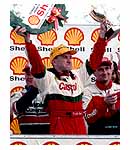 "Up
until about five years ago, Touring Cars were just a closed shop.
Unless you were part of the establishment, a young driver didn't
have a chance in hell of getting in. Now the old guys are retiring
and they (the teams) are finally looking for new talent. It's only
been the last two years or so where the top teams have been actively
recruiting young blokes straight out of Formula Ford." "Up
until about five years ago, Touring Cars were just a closed shop.
Unless you were part of the establishment, a young driver didn't
have a chance in hell of getting in. Now the old guys are retiring
and they (the teams) are finally looking for new talent. It's only
been the last two years or so where the top teams have been actively
recruiting young blokes straight out of Formula Ford."Lowndes, in contrast to that early tradition, appears to have been promoted in line with his ability and achievements. Oakley and Yamaha now join Mobil and Holden on the list of personal sponsors enjoying an association with this fresh-faced celebrity in an exciting and rejuvenated sport. "The category (V8 Supercars) is a lot fairer these days, especially with the new control tyre," says Craig, "nobody can get up and run off with it any more. The top dozen or so cars are now within a second of each other and that makes it more of a spectacle, more exciting to watch. The switch to an all-V8, Holden versus Ford formula a few years ago also proved to be the right way to go. "It's now much more of a 'control' category like NASCAR, which is America's biggest sport. Apart from the engines, the front suspension and obviously the bodywork, our cars, like NASCAR, are very similar. There has to be a lesson in that somewhere. 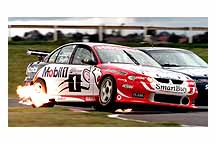 "There
are more competitors now than ever before, more spectators and more
TV thanks to Channel 10. There are new circuits and locations like
Darwin, Ipswich and Adelaide appearing, and now there's talk of
overseas events, so there's obviously more international appeal
now apart from just Bathurst. "There
are more competitors now than ever before, more spectators and more
TV thanks to Channel 10. There are new circuits and locations like
Darwin, Ipswich and Adelaide appearing, and now there's talk of
overseas events, so there's obviously more international appeal
now apart from just Bathurst.Although Lowndes hasn't closed the book on a return to international formula racing, his immediate future is certainly bright in our homegrown 'tin-top' racing. Having said that, with the burgeoning globalisation of sport and the media, it may well be our own V8 Supercars that thrusts him back on the international stage - and on to even greater heights.  As published in Sports Australia Magazine |